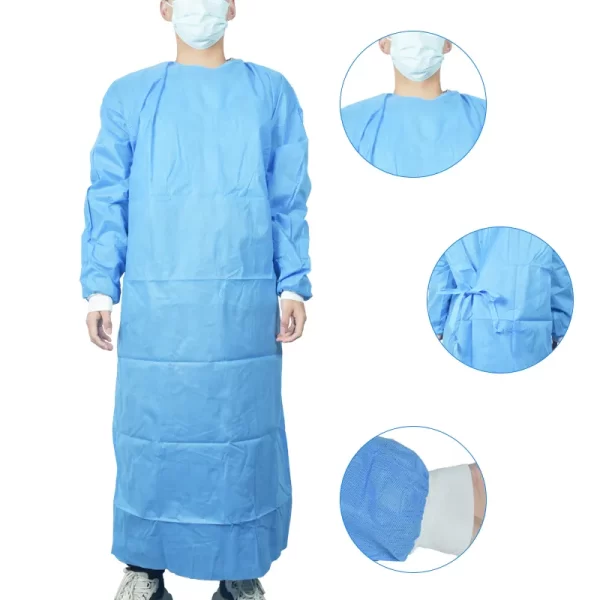“The Art and Science of Crafting Sterile Surgical Gowns: An In-Depth Look into the Manufacturing Process”
Introduction
In the grand tapestry of healthcare safety, sterile surgical gowns are threads woven inextricably into the very fabric of patient care. These unassuming garments serve as silent guardians, shielding both patients and healthcare providers from the invisible menace of infectious agents. But how are these vital shields manufactured? In this comprehensive article, we delve into the intricate process of crafting sterile surgical gowns.
Material Selection: The First Step Towards Protection
The genesis of a sterile surgical gown lies in the careful selection of the appropriate material. This choice is dictated by several factors, including but not limited to, barrier performance, comfort, durability, cost-effectiveness, and environmental impact.
Commonly, surgical gowns are crafted from non-woven materials like polypropylene, polyester, polycarbonate, or a blend of these. These materials are favored for their inherent ability to provide a formidable barrier against microbes and fluids, while also ensuring wearer comfort. In recent years, there has also been a surge in the development and use of biodegradable materials for surgical gowns, as the industry seeks to reduce its environmental footprint.
The Blueprint: Designing and Cutting
With the appropriate material in hand, the next step involves designing the gown. The design process needs to ensure that the gown provides complete coverage while also allowing ease of movement. This balancing act is crucial as it directly impacts the wearer’s comfort and efficiency in the operating room.
Typically, surgical gowns are designed to cover the body from the neck to the knees, with long sleeves ending in elastic cuffs. Some designs also incorporate thumb loops to prevent the sleeves from sliding up during procedures. Additionally, surgical gowns are often equipped with ties or belts that help secure the gown on the wearer and ensure a comfortable fit.
After the design is finalized, cutting machines, guided by precise software systems, accurately cut the fabric according to the design templates, setting the stage for the assembly of the gown.
The Assembly Line: Sewing and Construction
The cut-out pieces are then sewn together to construct the gown. This process is often automated, with sewing machines programmed to stitch the gown together in a specific pattern that ensures both the gown’s structural integrity and its protective capabilities.
Special attention is paid to the seams, the critical points where different pieces of fabric are joined. The seams must be robust and leak-proof, as they are potential weak points that could compromise the gown’s barrier function. Reinforcements are often added at these seams and other high-stress points to ensure maximum protection.
This stage also involves the addition of ties, belts, and elastic bands to the cuffs of the sleeves, enabling a snug and secure fit. These components are carefully sewn into the gown, ensuring they are firmly attached and can withstand the rigors of the operating room.
Upholding Standards: Quality Control Checks
Before proceeding to the sterilization stage, each surgical gown undergoes rigorous quality control checks. These inspections are critical in ensuring that each gown meets the stringent standards set by regulatory bodies like the FDA and the EMA.
During these checks, each gown is inspected for any defects or imperfections, such as weak seams, holes, or inconsistencies in the material. The gown’s resistance to liquid penetration, seam strength, and lint generation are also tested. Any gown that does not meet the standards is discarded, ensuring that only the highest quality gowns proceed to the next stage.
The Final Gatekeeper: Sterilization
The sterilization process is perhaps the most critical stage in the manufacturing of sterile surgical gowns. This process ensures that the gown is free from any bacteria, viruses, fungi, or other potential pathogens, making it safe for use in surgical procedures.
The gowns are generally sterilized using methods such as Ethylene Oxide (ETO) sterilization, or gamma radiation. ETO sterilization involves exposing the gowns to ethylene oxide gas, a potent sterilizing agent. In contrast, gamma radiation sterilization involves subjecting the gowns to ionizing radiation, effectively killing any microbes present.
Preparing for the Journey: Packaging and Labelling
Once sterilized, the surgical gowns are ready to be packaged. Each gown is individually packed in a sterile pouch and sealed to maintain sterility until use. The packaging is done in cleanroom conditions to prevent any potential contamination during the process.
The packaged gowns are then labeled with necessary details like the date of manufacturing, expiry date, sterilization method, and size. This information is critical for healthcare providers, ensuring they can make informed choices when selecting a gown.
The packed gowns are then boxed in larger cartons, ready for dispatch to healthcare facilities worldwide.
Conclusion
The manufacturing process of sterile surgical gowns is a meticulous balance of art and science, where each step contributes to the creation of a garment that plays a vital role in the healthcare sector. This silent guardian, born from simple fabrics, serves as a robust shield in the operating theatre, safeguarding both patients and healthcare providers.
As the sterile surgical gown industry continues to evolve, so too does the manufacturing process. With advancements in technology and materials science, we can anticipate the development of even more effective and sustainable surgical gowns.
Through this detailed exploration of the production journey of sterile surgical gowns, we hope to have imparted a deeper appreciation for this often-underestimated piece of medical apparel. Keep an eye on our platform for further insights into the fascinating world of medical apparel manufacturing.
Please visit our website for more product details https://medposnonwoven.com/product/surgical-gown-disposable/

